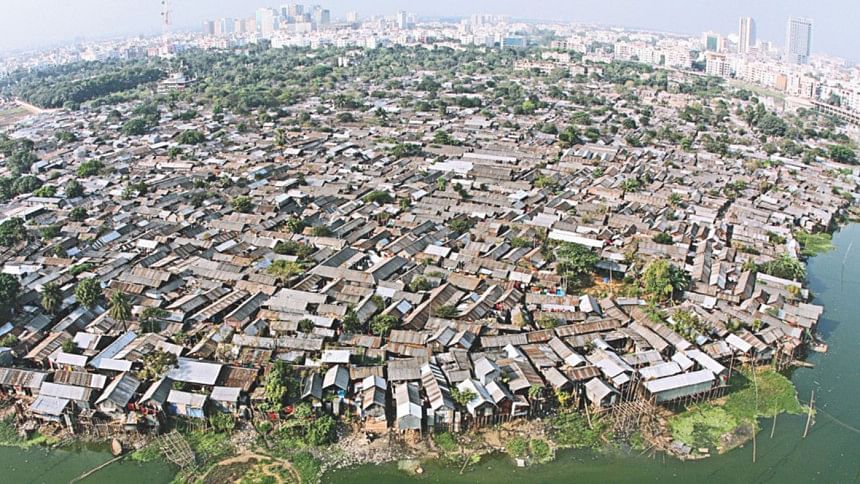What do we need DAP for if it makes the city further unliveable?

After years of wait, we are finally going to get the Detailed Area Plan (DAP) 2016-35 for Dhaka. Yet, there is nothing to be happy about it. Rather, it is quite shocking to learn about the countless flaws in the proposed DAP that have been pointed out by urban planners. Reportedly, the draft DAP was finalised without taking the suggestions of all the stakeholders—urban planners, architects, environmentalists and the government agencies concerned. As Rajuk has finalised the draft, debates have been raging among city planners as well as the general public on whether it would eventually make the city further unliveable and only satisfy the greed of some powerful quarters.
There are enough reasons to be worried.
Since the previous detailed area plan (DAP) remained largely unimplemented in the face of opposition from politically powerful quarters and influential realtors, and its tenure expired in 2015, the government took the initiative to formulate the DAP 2016-2035, which should have been completed a long time ago. However, according to the Town Improvement Act 1953, the government is supposed to formulate the Dhaka Structure Plan 2016-2035 before formulating DAP 2016-2035, which has not been done. So, there are some clear legal contradictions. And we do not know why it is taking so long for the government to publish the gazette notification of the structure plan since it has already been finalised.
According to the Institute of Architects Bangladesh (IAB), the implementation of the draft DAP will result in destruction of 70 percent of the natural water bodies in and around the city. Architects have also warned that the proportion of flood flow zones will be reduced to 17 percent if it is implemented, whereas the 1997 structure plan for Dhaka intended to keep 66 percent of the flood flow zones.
According to IAB, "There is a clear point in the Terms of Reference for preparation of the DAP, which mentions demarcating rivers, canals, water bodies, water retention and catchment areas based on surveys done during the British and Pakistani eras and mouja maps." Sadly, the draft DAP has ignored this point and proposed a modification in the classification of flood flow zones.
It has proposed two separate terms to define the flood flow zones—primary waterbody and general waterbody—and mentions allowing construction (conditionally) on the general waterbodies. This classification goes against Bangladesh Water Act-2013, according to which the characteristics of the flood-flow zones cannot be changed.
Dhaka's waterlogging problem has become so acute over the last few years that the only way to solve this urban disaster is to preserve the city's remaining canals, ponds and waterbodies and reclaim those that have already been grabbed. According to Adil Mohammad Khan, general secretary of Bangladesh Institute of Planners (BIP), water retention bodies, including ponds and canals, should cover 12 percent areas of a planned city. Sadly, Dhaka has less than two percent of such area (The Daily Star, July 22, 2020). And we all know why. A 2019 Daily Star report revealed that individuals, businesses, real-estate developers, and even government agencies have gobbled up 1,072 acres (57 percent) of the 1,879-acres of flood flow zones in core Dhaka city only in this decade.
However, if the DAP 2016-2035 is implemented in its current form, it would contribute to more waterlogging in the city as scopes have been created in its provisions to allow building structures on "general waterbodies."
While solving Dhaka's waterlogging problem would require establishing an integrated network of drains, canals, rivers and flood flow zones, which is called the "Blue Network" in the Dhaka Structure Plan, there is no mention of it in the draft DAP.
According to Iqbal Habib, joint secretary, Bangladesh Paribesh Andolon, "Instead of giving specific proposals to recover the 65 identified canals of Dhaka (now there are only 26), the draft has, in fact, allowed people to build houses in plots that are adjacent to the narrow canals and have no road connectivity. This would certainly encourage the unscrupulous plot owners to grab the canals for making roads."
"The flood flow zones, agricultural land and water retention areas should be preserved according to the guidelines of the Dhaka Structure Plan 2016-2035, which has not been done in the draft DAP," points out Dr Akter Mahmud, Professor, Urban and Regional Planning, Jahangirnagar University.
The need for conservation of the ponds, canals, rivers and flood flow zones, reclaiming the canals and waterbodies that have already been grabbed, and creating water retention ponds have always been highlighted by experts to prevent the city's waterlogging and flooding issues. Why then did conservation not get due importance in the draft?
Meanwhile, river and wetland grabbing by politically powerful people continue unabated. Only last Tuesday, The Daily Star reported that a ruling party MP has filled up more than 54 acres from the Buriganga river and wetland to construct a power plant and a private economic zone in Basila. As the National River Conservation Commission's (NRCC) probe has found, out of the 54 acres, at least 12.78 acres was part of the Buriganga, according to the oldest land record available, known as the Cadastral Survey (CS). And the rest of the 54 acres was wetland along the river and marked as flood-flow zone in the DAP.
The draft DAP, with its countless flaws, has disappointed those of us who had hoped that DAP would transform Dhaka, one of the least liveable cities in the world, into a liveable and sustainable city. Besides threatening the existence of the natural waterbodies of the city, the proposed DAP 2016-2035 has made many other proposals that would only serve the interests of some powerful quarters, dishonest business people and greedy realtors.
For instance, in the proposed DAP, only five percent of the city area has been designated as purely residential, the rest will be a mix of residential and commercial areas, which will seriously harm the city's environment. There is a provision to allow constructions that deviate from the building codes and do not have approval in exchange of a fine, which will only encourage the law-breakers. It also has controversial provisions about keeping road space. Furthermore, this draft does not emphasises low-cost housing facilities for low-income and poor people despite the fact that over 40 lakh people in Dhaka live in slums.
Needless to say, the proposed DAP needs critical evaluation by all stakeholders. Already the major loopholes in the provisions have been identified by city planners, architects and environmentalists. The government must listen to their suggestions and correct the flaws for making the Detailed Area Plan 2016-2035 for Dhaka efficient and sustainable.
Naznin Tithi is a member of the editorial team at The Daily Star.

 For all latest news, follow The Daily Star's Google News channel.
For all latest news, follow The Daily Star's Google News channel. 



Comments